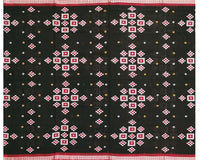The Process of Weaving
Each and Every thread of the Odisha sarees are Hand woven. All the process involved in weaving a saree is carried out manually, no machine is used in any of the steps.

The process starts with dyeing the cotton/silk material. In short, the coloring process includes dipping the material repeatedly in the boiled color water. Utmost care is taken while dyeing the cotton/silk to make sure that the color is uniform throughout the material and it doesn't affect the quality of the material.
Handloom Weaving
Weaving is a method of fabric production in which two distinct sets of yarns or threads are interlaced at right angles to form a fabric or cloth. The longitudinal threads are called the warp and the lateral threads are the weft or filling.
A handloom is a machine used for weaving. In a wooden vertical-shaft loom, the heddles are fixed in place on the shaft. The warp threads pass alternately through a heddle, and through a space between the heddles (the shed), so that raising the shaft raises half the threads (those passing through heddles), and lowering the shaft lowers the same threads-the threads passing through the spaces between the heddles remain in place.
Handloom Weavers
Handloom weavers were mainly men, due to the strength needed to batten. They work from home sometimes in a well-lit attic room. The women of the house would spin the thread they needed, and attend to finishing.

Later women took to weaving, they obtained their thread from the spinning mill and working as out workers on a piecework contract.







